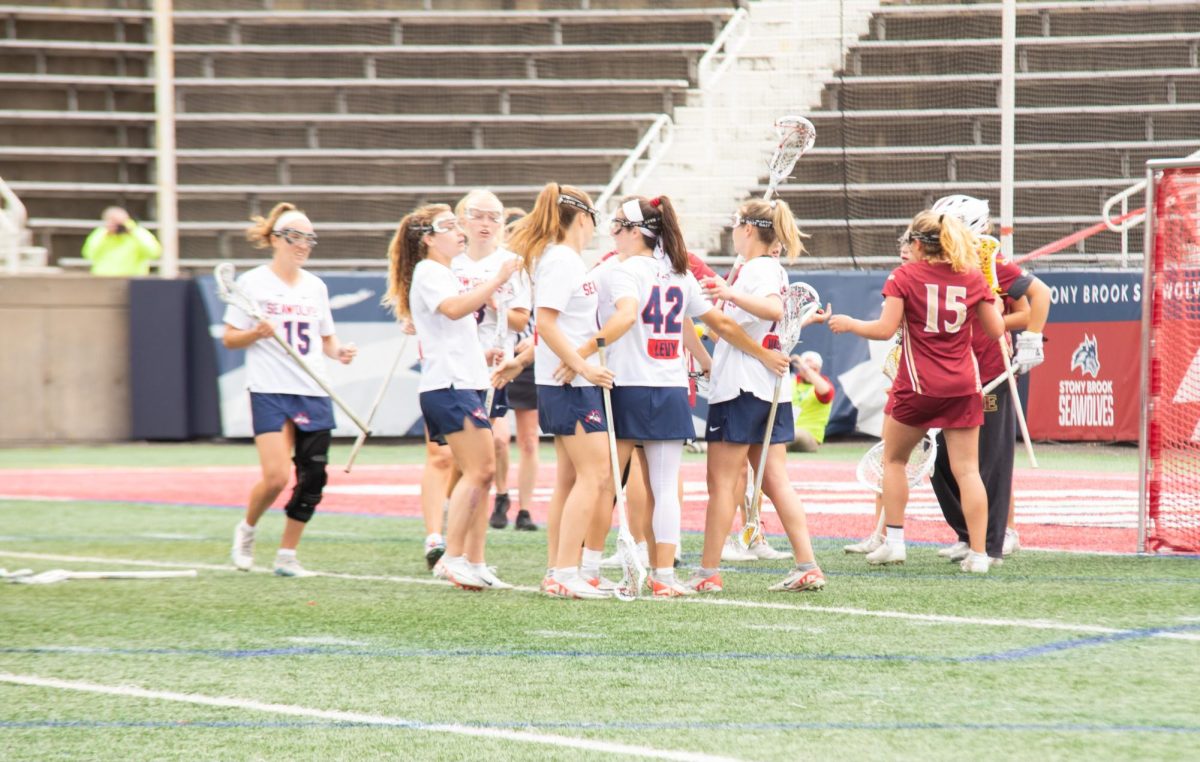The black stage was hot under the blazing sun. Everyone was barefoot and this was the first performance for a few of the members. The thought of messing up was not the only thing going through their minds.
“Do I look fat?”
“Will I remember the dance?”
“Do I look pasty?”
But those thoughts quickly disappeared. The adrenaline rush took over and now they shimmy their hips from side to side. They move in a blur and drift across the stage to the music without fault.
Some of the girls look back on that first performance and cringe. But it was the beginning of a long ride that has made them one of the most recognized clubs on campus.
They are the Stony Brook belly dancers, and what they do cannot be described easily. They move in ways that most people can’t imagine possible. They have learned to use muscles not normally used and separate their body parts when they dance.
They are a group of 11 girls known for jingling throughout campus, because of the clinging coins on their elaborate costumes. Each member joined for a different reason. They are closer than family, a sorority. Some had no dance background and some have been doing it for their entire lives. But they all said the friends they made are what kept them there.
But unlike so many other groups on campus they pride themselves on their diversity. They are as different as the costumes they wear. They’re all different nationalities, sizes and shapes. They differ in faith and major, color and age. The president of the club, Sahita Pierre-Antonie, is from Haiti and they have even had girls from Japan.
“We are one of the only clubs that not only have girls from all over the country but literally all over the world,” said Amanda Cervone, a junior and business major as she watched the other girls practice for that night’s performance. “We have such a beautiful mixture and it’s good because we have all different body types,” described the 20-year old spunky brunette in a Supergirl top as her friends practiced a dance she needed to learn.
Amanda has been on the team since she saw them perform at club day during her first semester. She fell in love with belly dancing instantly and has been doing it ever since. It boosts her self-esteem. Going on stage is hard enough, but doing it in a bra and flashy blue skirt that makes her stand out even more is even harder.
“I rarely ever get nervous,” Amanda said, “Its second nature now, really. The first year was rough; there was a lot of anxiety. Being pale sucks too – doesn’t matter what I do I’m always going to be pale.” She said she’s still tied with Alanna McGovern, a sophomore on the team, for the title of palest person.
Leah Pagnozzi, a tiny blond biomedical engineering major from upstate New York, has been on the team for about a year. When she preformed for the first time she was not at all nervous. All that was going through her head was, “this is fun and I look shiny.”
But nervous is not something that Leah can afford to feel. Last semester she joined the Reserve Officers’ Training Corps and was going to have to miss a performance on Saturday. She would be in the woods shooting people with BB guns.
She says belly dancing and ROTC are two different aspects of her personality. One more structured and disciplined, the other more free and artistic.
Belly dancing is an old dance. Its origins stem from childbirth and relieving tension. It is traditionally a Middle Eastern dance but has stretched all over the world. There are many styles of the dance ranging from Egyptian to Australian and even male belly dancing. Some think it’s just exploitive and demeaning but it’s anything but that.
“We try so hard not to make it sexy,” Amanda said. “We put effort into making sure we are not putting ourselves out there any more then we already do.”
“It’s sexy but it’s not slutty,” said Victoria Farenga, a sophomore and liberal arts major whose enthusiasm about the team and the dance can’t be met by anyone else.
To the average person, belly dancing could look like a bunch of attractive college girls shaking around the stage in very little clothing, but it’s hardly that simple. These girls need to be completely attuned to and aware of every part of their body.
They’ve even separated their stomachs into four areas. “Part of the dance is to separate the parts of your body,” Amanda explained, “Upper and lower body are our two main separations but we really learn to separate every part of the body, our hips, our fingers our necks.”
They move in a hypnotizing and at the same time seductive way – gracefully but at the same time in power of their body.
“It’s an ethnic and cultural dance that empowers the feminine body,” said Melissa Bhagwatprasad, a junior from Brooklyn with an Indian background who has been on the team for three years.
The team spends almost six hours a week on practicing and teaching the dance. But it is possible to learn. Sahita, a junior and political science major who is now the president of the club, had no belly dancing experience when she started.
“I just tried out,” Sahita said as she stretched, getting ready to prepare the team for a performance. And although she said she never gets nervous about performing, she does worry about the audience.
“I’m worried how they will react because we draw on their energy,” she said.
The club meets three times a week. Dancing is taught on Tuesdays. On Wednesday at a fitness workshop, dancing is faster and more exercise based. On Fridays they hold team practice where it all comes together.
There’s no discri-mination as to who is allowed in the club. Anyone and everyone who wants to learn are invited. There were even some males at the fitness workshop on a recent Wednesday.
Gerard Oh, an Asian student, was one of the few males at Wednesday’s class. But he quickly made himself at home. He was moving better than some of the girls as he lifted his green shirt up so he could see his waist better.
“I want to learn to belly dance because men think belly dancing is a women’s dance,” he said afterwards as he ran out of the studio.
It’s easy to get discouraged during these classes. They work muscles that are not normally used.
“If you feel stuff jiggle it’s good,” Alanna told the class of nine in the dance studio.
“You feel bad about yourself, but it’s how you learn,” Melissa added.
But the team is separate from the club. The team consists of the best of the best dancers.
They shimmy their shoulders and hips as they glide gracefully through the room. Their multi-colored costumes move and sway with their hips. A mixture of red, blue and green are a bright addition to the darkness of the Black Box Theater in the Tabler Arts Center.
It’s flashy and catches people’s attention. When they performed their movements were even more fluid and sharp than during the hours of practice they had that week. No one took their eyes off the team when they were on. And they finished to loud applause.
But something set this apart from that first performance.
No one was nervous. Victoria and Jessica were dancing around before they started. And the only complaint was how long they had to wait to perform.
“Now I’m just happy to be doing it and just want to wow the crowd,” Victoria said, “I mean who else gets to do this?”










